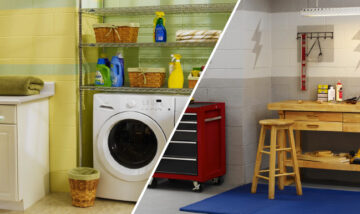Concrete is a common material used in building designs, typically found in garages, sheds and basements for the floors or walls. However, concrete is becoming a popular material to use for flooring in the interior of homes as well.
Because water is one of the main ingredients in concrete (along with Portland cement and aggregate material), it is particularly susceptible to moisture. When it absorbs water, the concrete expands and retracts, which can result in cracks. Factors like ambient relative humidity (RH), the concrete mixture, geographic climate, aggregate materials and vapor retarders, among others, can all affect the overall rate of concrete moisture evaporation.

This can present a challenge when preparing concrete for paint, and the process can vary slightly depending on whether the concrete is old, new or is being repainted. The following steps are critical before painting any type of concrete.

1. Clean the Area
The first step in preparing concrete for paint is to thoroughly clean the area. Whether you’re preparing old or new concrete surfaces for painting, it’s important to remove any surface debris that can easily be swept up or vacuumed. Before moving on to the next step, the area should be free of leaves, dirt, trash, grass, rocks and other debris. To remove any stains or grease, use a heavy-duty detergent until the surface is free from stains. Be sure to remove any old paint as well to get the best results.
Pressure washing can be a good option to ensure that you’ve gotten the best clean possible. To avoid damage to the concrete when pressure washing, don’t use a pressure setting above 1,750 PSI.
If you spot efflorescence — a white, powdery substance that commonly appears when preparing concrete blocks for painting — no need to worry. That can be removed with step two.
2. Apply an Etching Solution
After cleaning the concrete and allowing it to dry, apply an etching solution. This step will take care of any efflorescence (salt deposits) and prepare the surface for painting. Before etching, ensure that all old paint has been removed from the surface.
DRYLOK® Concrete and Masonry Liquid Etch & Clean cleans, etches and brightens the concrete in one step, and it is a safer alternative to muriatic acid, which is highly corrosive and reactive.
3. Fill All Cracks
To achieve a smooth surface that is ready for paint, fill any cracks, holes or other surface defects. After filling in the cracks, any pieces that stick out from the concrete need to be sanded, ground or chipped smooth.
This is an important step because any exposed areas are susceptible to water infiltration and moisture mitigation that will create issues later on. In addition to cracks, if you’re preparing a concrete garage floor for painting or other spaces with a floor wall joint, you should also fill the area where the floor meets the wall.
Choose a fast-setting hydraulic cement, like DRYLOK® Fast Plug that creates a watertight seal in 3 to 5 minutes. You can also use DRYLOK® Masonry Crack Filler, a ready-to-use acrylic, fortified with silicone caulk.
4. Apply Concrete Sealer if You Don’t Want a Painted Surface

If you’re preparing interior concrete but will not want to paint, the next step is to apply a concrete sealer to keep excess moisture out and ensure that the whole area is sealed. Depending on the specific application, DRYLOK® sealers and waterproofers can achieve a surface that will resist moisture, increasing your surface’s longevity.
5. Thorough Wash and Moisture Test
Once the sealer has set (which can take up to 24 hours), thoroughly wash the space and let it dry completely. After it’s dry, do a moisture test to ensure that any trapped moisture has been released.
To check for trapped moisture, tape a 12” x 12” piece of 3‑mil plastic or aluminum foil to the surface, making sure all four edges are taped tightly. Wait 24 hours and remove it. If the floor side of the plastic or foil is damp, allow additional time to dry and then test again until the floor side is dry.
To speed up the drying process, try using a dehumidifier or fan — it can also help get rid of any trapped moisture.
6. Purchase the Right Paint
When you’re choosing paint, be sure to choose one specifically formulated for use on concrete. Choosing an all-in-one paint and primer, like DRYLOK® Latex Concrete Floor Paint, will eliminate the need to do a separate coat of primer. In addition, options like DRYLOK® E1 Latex 1‑Part Epoxy Concrete Floor Paint are perfect for a showroom-quality interior or exterior finish.
7. Apply Two Coats
After preparing the concrete surface and selecting your desired color, apply the first coat of paint and allow it to dry thoroughly — it takes about 4 hours. After the first coat is completely dry, remove any bumps or imperfections from the concrete surface by sanding or scraping the surface.
When you apply the second coat, be sure to get the paint into any spaces that the first coat didn’t cover. The second coat should be applied in the opposite direction of the first coat in order to achieve a uniform color. After painting, let the concrete surface dry thoroughly for at least a few days.
The Best High-Quality Masonry Preparation Products
For the best high-quality preparation products, DRYLOK®’s extensive masonry product line has you covered from cleaning to completion. In fact, our concrete floor paint was listed by familyhandyman.com as the overall best paint on the Best Concrete Paints for 2021 list.
With a fast-drying and non-slip finish, our products will help your project go smoothly from start to finish. Click here to find where to buy DRYLOK® products near you.





